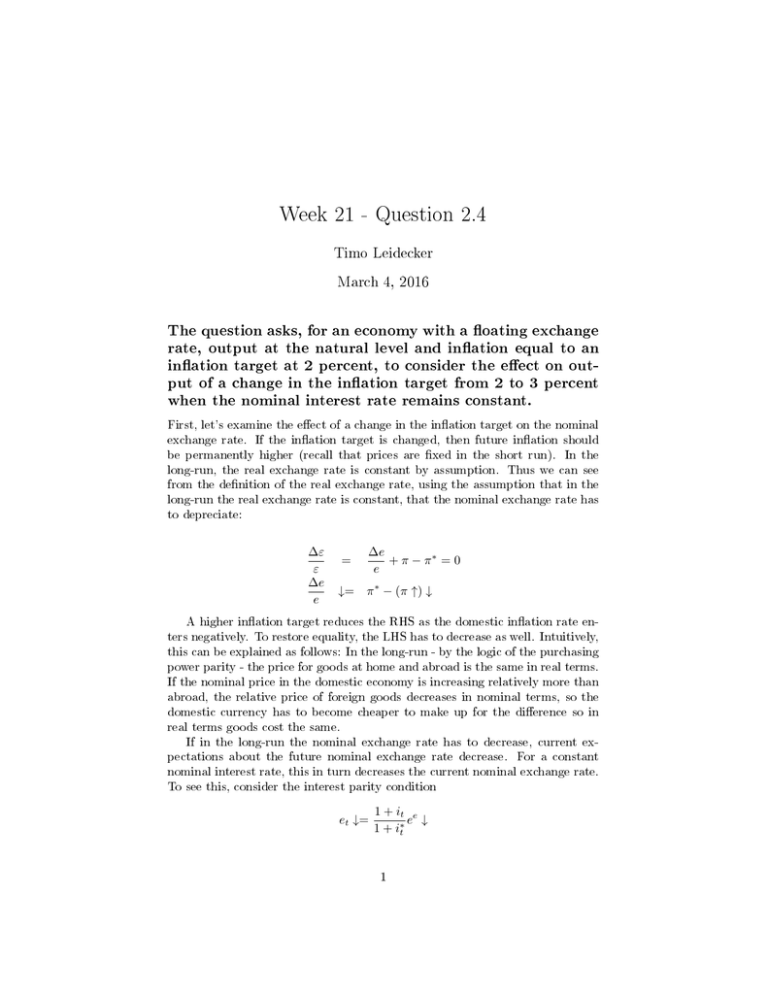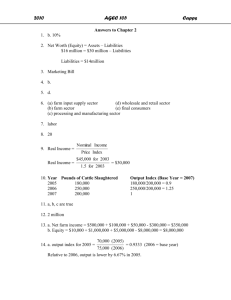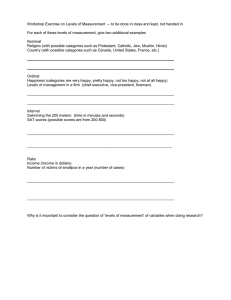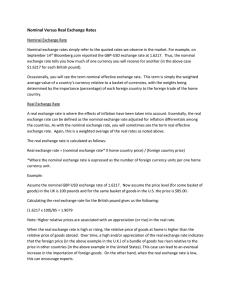Week 21 - Question 2.4
advertisement

Week 21 - Question 2.4 Timo Leidecker March 4, 2016 The question asks, for an economy with a oating exchange rate, output at the natural level and ination equal to an ination target at 2 percent, to consider the eect on output of a change in the ination target from 2 to 3 percent when the nominal interest rate remains constant. First, let's examine the eect of a change in the ination target on the nominal exchange rate. If the ination target is changed, then future ination should be permanently higher (recall that prices are xed in the short run). In the long-run, the real exchange rate is constant by assumption. Thus we can see from the denition of the real exchange rate, using the assumption that in the long-run the real exchange rate is constant, that the nominal exchange rate has to depreciate: ∆ε ε ∆e e = ∆e + π − π∗ = 0 e ↓= π ∗ − (π ↑) ↓ A higher ination target reduces the RHS as the domestic ination rate enters negatively. To restore equality, the LHS has to decrease as well. Intuitively, this can be explained as follows: In the long-run - by the logic of the purchasing power parity - the price for goods at home and abroad is the same in real terms. If the nominal price in the domestic economy is increasing relatively more than abroad, the relative price of foreign goods decreases in nominal terms, so the domestic currency has to become cheaper to make up for the dierence so in real terms goods cost the same. If in the long-run the nominal exchange rate has to decrease, current expectations about the future nominal exchange rate decrease. For a constant nominal interest rate, this in turn decreases the current nominal exchange rate. To see this, consider the interest parity condition et ↓= 1 + it e e ↓ 1 + i∗t 1 Figure 1: Question 2.4 i IP' IP i IS e e1 Yn e2 Y1 For a xed nominal exchange rate, this shifts the IP curve to the right (to IP'): For a given foreign nominal interest rate and lower expectations, for every nominal interest rate the nominal exchange rate will be lower. Also, the IS curve shifts to the right (to IS'): For a lower nominal exchange rate and, in the short-run xed prices, the real exchange rate decreases, so NX increase and aggregate demand is higher for every nominal interest rate. In the short-run, we end up in a situation where the nominal exchange rate is lower (e1 to e2 ), the nominal interest rate is the same, and output is above the natural level at Y1 . Results are shown in gure 1. Just as a side note, over time prices would adjust to the higher ination target of course, and the real exchange rate would increase (to its natual level arguably), so the economy would end up at the natural level of output with higher ination and a lower nominal exchange rate. 2 IS' Y






